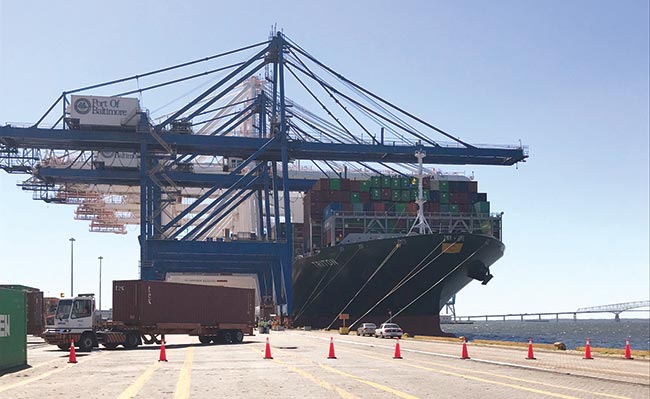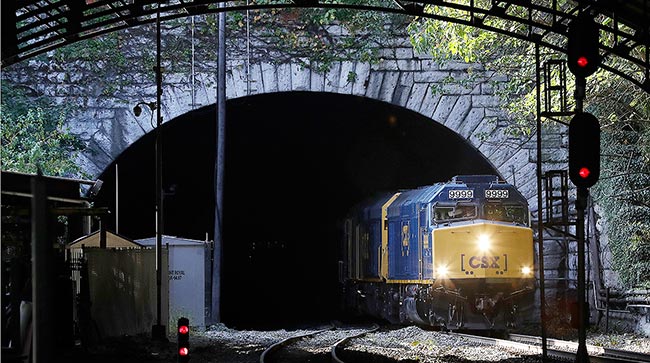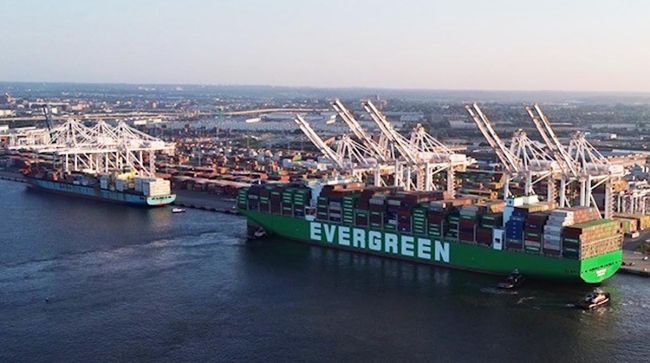The recently expanded Port of Baltimore is becoming a more important East Coast destination for containerships.
On Aug. 19, the largest containership to ever visit Maryland sailed into the Port of Baltimore. The Evergreen Ever Max arrived at the port’s Seagirt Marine Terminal from the Samsung shipyard in South Korea.
The Evergreen Ever Max weighs 165,350 tons, is 1,200 feet long (the length of four football fields), and has a capacity of 15,432 20-foot-equivalent units.
“It’s no secret why these massive containerships want to call on the Port of Baltimore,” Maryland Transportation Secretary Paul Wiedefeld said in a statement. “They know Maryland’s port is a valuable resource and a terrific partner in moving goods efficiently across the state and throughout the region.”
Big day at PoB! The biggest ship to visit, Evergreen’s Ever Max, is here! Port Admin’s Int Act Exec Dir, Brian Miller, gave Capt Chou an engraved ship’s wheel to celebrate. @pachesapeake‘s VP Mark Schmidt was also present. Ever Max can hold 15K+ 20-ft Equiv containers. @ILAUnionpic.twitter.com/XiZcCI8rFD
— Port of Baltimore (@portofbalt) August 19, 2023
The Evergreen Ever Max is a new ship and this is its maiden voyage, going through the Panama Canal, then stopping at the Port of Savannah, the Port Authority of New York/New Jersey, the Port of Virginia in Norfolk, then north back to Baltimore. The ship is now crossing the Atlantic and heading to Egypt.
Up until this arrival, the largest ship to call on the Port of Baltimore was the Triton, which arrived on May 24, 2019, and has a capacity of 14,424 containers.
The Ever Max’s arrival comes at a time when as other ports along the Atlantic and Pacific coasts are reporting significant, year-over-year declines in cargo, Baltimore is seeing its numbers increase. As of May, containers and general cargo were up compared to 2022. Specifically, roll-on/roll-off cargo was up 30%, containers were up 10% and general cargo is up 8%. The 2023 start follows a solid 2022 when the port handled a record $74.3 billion in foreign cargo, officials said.
Economist Paul Bingham, the director of transportation consulting with S&P Global Market Intelligence, told Transport Topics he could predict the Port of Baltimore’s importance coming more than 20 years ago when he worked as a project manager with the Army Corps of Engineers on an economic analysis concerning the deepening of the port’s harbor channel to 50 feet. Those decisions, he said, are now paying dividends.

The Triton stops at the Port of Baltimore on May 24, 2019. (Dan Ronan/Transport Topics)
“Baltimore is the most inland port on the East Coast. It literally is attached to I-95,” he said. “It’s close to major markets, like New York and Washington, D.C. The port operator, Ports America Chesapeake, has put a lot of effort into trying to improve the attractiveness of that terminal to the steamship operators.”
Bingham also said Baltimore’s location saves at least an hour for truck drivers heading to the Midwest, South and Northeast. That location was a critical factor in a developer’s decision to purchase and now turn the former Bethlehem Steel Plant into a 3,300-acre global logistics facility, Tradepoint Atlantic, that has been open for several years and has additional plans to expand.
And Baltimore’s likely to see further growth.
Starting in February, ZIM Integrated Shipping Services Ltd. said it would double its e-commerce service at the port with larger container vessels, and it was increasing the frequency of its Baltimore Express, from China and Southeast Asia to the East Coast. ZIM increased the size of its ships coming into the port by nearly 50%, starting first with 6,000-TEU container vessels before shifting to larger 8,000-TEU containerships.
Another expansion project is well underway and the port’s container business is expected to substantially increase with the nearly $500 million renovation of the CSX-owned Howard Street Tunnel, which is slated to be completed in 2025. The project involves improving clearance in the 127-year-old tunnel and at 21 other areas between Baltimore and Philadelphia that will allow for double-stacked railcars to go in and out of Baltimore.

A CSX Transportation inspection trainemerges from the Howard Street Tunnel in Baltimore. (Patrick Semansky/AP)
“Getting that service going is very important,” Bingham said. “Baltimore has been at a disadvantage because of the tunnel height restrictions. Neither the CSX or Norfolk Southern have been able to offer traditional, double-stacked intermodal service like you can run in New York or Norfolk, in competition with Baltimore.”
Even with the latest moves, Baltimore still lags other East Coast ports in container volume, averaging more than 67,000 TEUs in the past 12 months. However, the port ranks first in the country in roll-on, roll-off cargo, particularly agriculture equipment, such as combines, tractors, hay balers, excavators and backhoes. Most of the larger East Coast ports process more than 200,000 TEUs a month.
“I expect even larger vessels to begin calling Baltimore that can fit through the channel constraints because of the attraction to some of the shippers because of where that port is located,” Bingham said.






